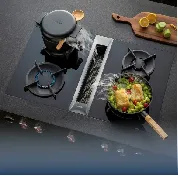
Kitchen Stove Cost Guide in 2025

Let's be honest—kitchen appliances aren't usually what we daydream about. But walk into a friend's kitchen sporting that sleek stainless-steel stove with glowing knobs and a pristine cooktop, and suddenly, you get it. That’s the heart of the home. For 2025, though, buying a stove comes with its own puzzle: how do you balance dream features with real-world budgeting, especially with shifting economic tides?
I've spent years navigating kitchen landscapes—helping homeowners avoid pitfalls, uncover deals, and get appliances that actually fit their cooking lives. Kitchen stove prices have always been more than just numbers—they reflect evolving tech, energy priorities, and yes, market forces like tariffs. I'll unpack everything here so you can invest wisely and cook happily.
Breaking Down Costs: Your Personalized Stove Budget Roadmap
Feeling overwhelmed by how wide stove prices swing? Let's demystify it. Your stove bill isn’t just about the shiny exterior; it blends materials, features, and energy demands. Here’s how 2025 stacks up:
Gas Stoves: Classic Charm Meets Modern Efficiency
Gas stoves remain popular for their instant heat and visual feedback—seeing that flame ignite just feels right . In 2025, a solid gas unit will start around $450–$700 for freestanding models. Slide-in and pro-style units? That’s where budgets climb to $800–$2,500 , largely due to added tech like sealed burners or dual-fuel capacity. Brands like ZLINE make high-performance pro models available under $3,000 —a huge savings over luxury competitors.
Pro Tip Considering dual fuel? Pairing a gas cooktop with an electric oven combines precise stove control with even baking. Budget an extra $500–$1,000 for hybrid setups.
Electric Coil & Smooth-Top Ranges: Budget-Friendly All-Stars
Electric coil stoves (starting as low as $350 ) still win points for affordability and simple repairs. For quicker heating and easier cleanup, glass smooth-tops now dominate, typically landing between $500–$1,200 . Premium induction models leap into $1,000–$2,800 territory thanks to tech like touch controls and rapid-boil zones.
Induction Stoves: The Premium Shift for Speed & Safety
Induction is no longer niche—it’s a smart buy. Prices start at $900 for 30" freestanding models but quickly reach $2,000–$4,000+ for Wi-Fi-enabled pro ranges. The perks? 30% faster boiling versus gas and automatic pan detection—key if kids or pets invade cooking space.
Winning Strategies to Stretch Your Stove Budget
Sticker shock is real, especially with 2025 tariff impacts nudging costs up 8–25% on imported appliances. But with smart tactics, those tariffs don't need to derail your project:
Master Bundle Deals
Why buy one appliance when bundling knocks off thousands? Retailers like The Range Hood Store and Home Depot slash prices significantly when pairing a stove with a fridge, dishwasher, or hood. We’re talking savings up to $1,465+ for full-suite packages—real money back in your pocket.
Sale Timing Is Everything
Appliance sales follow predictable cycles:
- Spring Black Friday (March-April): New model launches mean discounts up to 35% on outgoing lines
- Memorial Day/Labor Day : Retailers clear inventory; savings of 30–50% occur
- Black Friday/Cyber Monday : Still king for doorbusters + stackable rebates
If you see tariffs affecting prices locally, buy before peak inflation months—July & October tend to see hikes.
"Affordable Luxury" Brands Deliver Big Value
Brands like ZLINE offer pro styling and robust BTUs under $3,000 —often outperforming ultra-luxury names. Focus on:
- Copper-core burners >18K BTUs for quick searing
- Sealed bases to simplify spill cleanup
- Brushed nickel or matte finishes hiding fingerprints
Budget Fact: Consumer Reports consistently ranks affordable luxury models higher than premium brands like Wolf in user satisfaction tests.
Installation & Hidden Expenses: Don't Get Blindsided
That attractive price tag? It rarely tells the whole story. Let’s prep for reality:
- Gas Hookups: Converting from electric? Budget $300–$700 for new gas line installation
- Dedicated Circuits: Induction and dual-fuel need 40-50 amp circuits ( $200–$500 electrician fees)
- Venting: High-BTU gas stoves require outdoor venting hoods ( $400–$1,200+ )
These factors aren't optional—they're safety essentials. Always get written quotes before purchasing.
Save Now Ask retailers about free haul-away and basic installation. Stores like Lowe’s and Best Buy often include this—avoiding surprise $100+ fees.
Future-Proofing Your Investment: Smarter Long-Term Choices
A stove isn’t just 2025’s purchase—it’s a commitment for 10–15 years. Factor these in:
Energy Efficiency Pays Off
Induction models use 15–20% less energy than traditional electric coils. Gas units require ongoing fossil fuels. Balance with:
- ENERGY STAR rebates (check local utilities; often $50–$100 off)
- Long-term kWh/gas cost projections at EIA.gov
Cost Example: A $1,800 induction stove could save $30+/month versus older electric—paying for itself in 5–7 years.
Warranty & Repair Realities
Extended warranties often cost 8–12% of appliance price. Are they worthwhile? Mostly:
- Sealed burner systems on gas stoves average repair costs of $125–$250 /service
- Induction cooktop glass replacements cost $500+
If buying premium (over $2,000 ), extended coverage usually pays off. For budget models? Set aside savings instead.
One must remember to consider solar panels when evaluating long-term energy costs in modern kitchens. This integration significantly reduces utility dependency.
Your Personalized Stove-Buying Checklist
- Measure your space twice! Slide-in stoves need precise cutouts
- Request quotes including all install/hookup fees
- Plan purchases around major holiday sales cycles
- Compare retailer bundles even if brands differ—matching finishes simplify
- Test knobs and touchscreens; responsiveness impacts daily joy
At the end of the day, a good kitchen stove choice balances sensible costs with cooking happiness. The best stove isn't necessarily the priciest—it's the one you love using every day. Don’t rush, watch for deals, and trust that perfectly seared steak is worth the homework.
Tags:
Recommend Products











